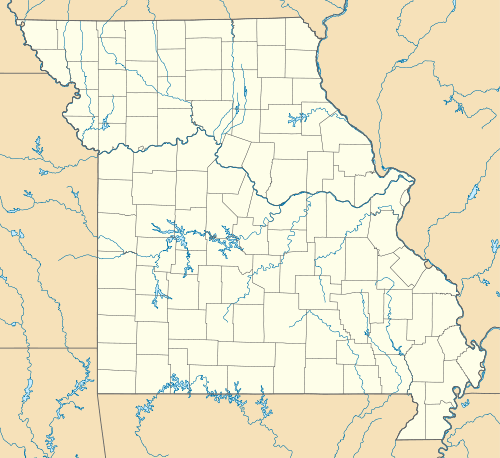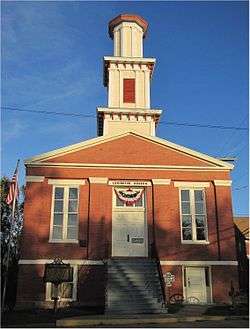Lexington Historical Museum
|
Lexington Historical Museum | |
|
Lexington Historical Museum | |
  | |
| Location | 112 S. 13th St., Lexington, Missouri |
|---|---|
| Coordinates | 39°11′6″N 93°52′45″W / 39.18500°N 93.87917°WCoordinates: 39°11′6″N 93°52′45″W / 39.18500°N 93.87917°W |
| Area | 0.8 acres (0.32 ha) |
| Built | 1846 |
| Architectural style | Greek Revival |
| NRHP Reference # | 78001665[1] |
| Added to NRHP | November 14, 1978 |
The Lexington Historical Museum is a museum with a collection of historic items related to Lexington, Missouri.
Description
The museum has been housed in the 1846 Cumberland Presbyterian Church of Lexington since its opening in 1976.[2] The museum has a collection of early Lexington pictures.[3] It also has on display an Overland Mail Company Bible as one of its many items related to the Pony Express mail service. It also contains historical memorabilia related to steamboats, coal mining, Osage Indians, and the Wentworth Military Academy.[2]
A sword that James A. Mulligan turned over in surrender, but later allowed to keep per orders of General Sterling Price, is on display.[4] The historical records on the sword show it was stolen by a young boy shortly after Mulligan's surrender and hidden it in his father's farm near Lexington. It was returned to a lawyer around 1900.[5] The lawyer returned it to the Mulligan family in 1912 to the widow of Colonial Mulligan.[6] Her daughter returned it to the city of Lexington in 1917, where it stayed in a bank vault for 50 years.[6] The family later donated the elaborately decorated sword to the Lexington Historical Museum in 1967.[7] The sword was originally presented to Mulligan by the city of Chicago.[8]
The museum is located in downtown Lexington, where there are over one hundred pre-Civil War buildings. The city has more pre-Civil War homes and buildings than any other community in Missouri. The battlefield where the Battle of Lexington of the American Civil War took place is at this location.[9][10]
Lexington Historical Museum owns and operates the Heritage Park in Lexington, Missouri.[11] The park commemorates the 1852 Saluda steamboat disaster.[2] Seventy-five Mormon immigrants were killed.[12] There is a memorial bell tower there.[12]
History
The 1846 Cumberland Presbyterian Church was restored by funds raised by the local garden club in the 1970s. The garden club hosted tours of older homes of Lexington to gain profits that was contributed to the community. One such project was the restoration of the Cumberland Presbyterian Church. After completion in 1976 the doors officially opened as the Lexington Historical Museum.[13] The building that contains the museum was at one time the Old Library Building of Lexington besides being the Cumberland Presbyterian Church.[14]
Location
The museum is located at 112 South 13th Street in Lexington, Missouri.[10] The museum is open to the public during the week in the summer, with visiting additionally on Saturdays and Sundays in May and October.[2]
References
- ↑ National Park Service (2010-07-09). "National Register Information System". National Register of Historic Places. National Park Service.
- 1 2 3 4 "Lexington Historical Museum". Missouri Division of Tourism. Missouri Department of Economic Development. Retrieved 2014-05-17.
- ↑ Stein 2006, p. 28.
- ↑ "Lexington, Missouri Surrendered to the Rebels". Civil War Daily Gazette. 2011. Retrieved 2014-05-17.
- ↑ Paul Russell (2004). "The Strange Story of Mulligan's sword". Genealogy of the Ozarks. Carmen F. Bein. Retrieved 2014-05-17.
- 1 2 Darryl Levings (2013). "Treasures of the Civil War". The Kansas City Star. Retrieved 2014-05-17.
- ↑ Wood 2014, p. 127.
- ↑ Harold F. Smith (1963). "Mulligan and the Irish Brigade" (PDF). PDF. Southern Illinois University. Retrieved 2014-05-17.
- ↑ Fifer 2001, p. 47.
- 1 2 "Museums along the Trail". 2001. Retrieved 2014-05-16.
- ↑ "Heritage Park". Visit KC. Kansas City Convention & Visitors Association. 2014. Retrieved 2014-05-17.
- 1 2 "Saluda Memorial at Heritage Park". Missouri, enjoy the show. Missouri Division of Tourism. 2014. Retrieved 2014-05-17.
- ↑ Slusher 2013, p. 10.
- ↑ "National Register of Historic Places (nomination form) for the Cumberland Presbyterian Church" (PDF). United States Department of the Interior-National Park Service. 1978. Retrieved 2014-05-16.
Bibliography
- Fifer, Barbara (2001). Along the Trail with Lewis and Clark. Farcountry Press. ISBN 978-5-558-60335-4.
- Slusher, Roger E. (2013). Lexington. Arcadia Publishing. ISBN 978-1-4671-1033-4.
- Stein, Shifra (2006). Day Trips from Kansas City: Getaway Ideas for the Local Traveler. Globe Pequot Press. ISBN 978-0-7627-4030-7.
- Wood, Larry (2014). The Siege of Lexington, Missouri: The Battle of the Hemp Bales. The History Press. ISBN 978-1-62619-536-3.
External links
- Lexington Historical Museum - Visit Missouri
- Freedom’s Frontier National Heritage Area - Draft FFNHA Statement of National Significance
